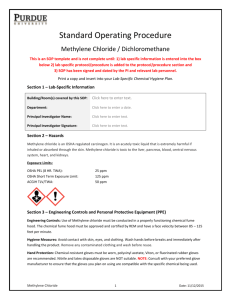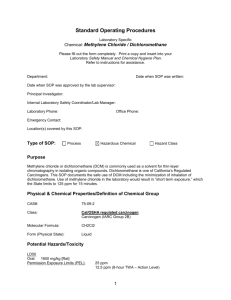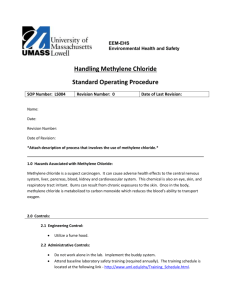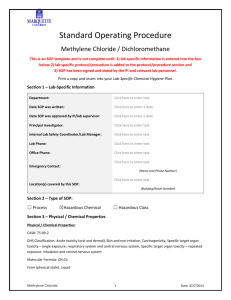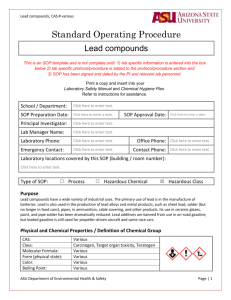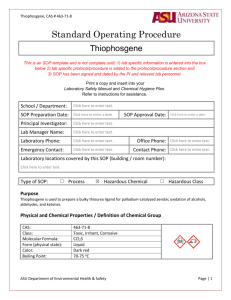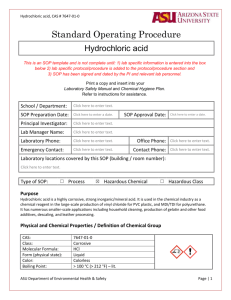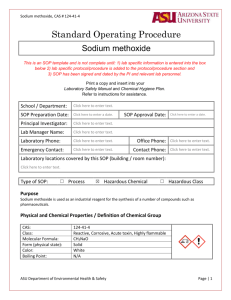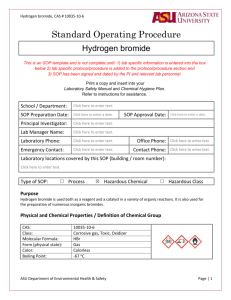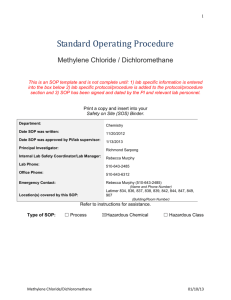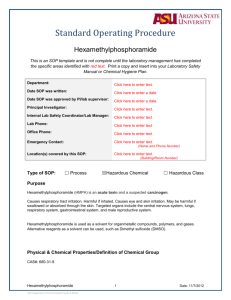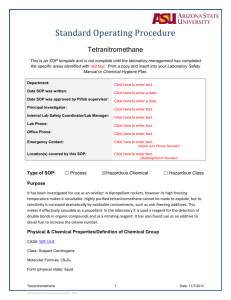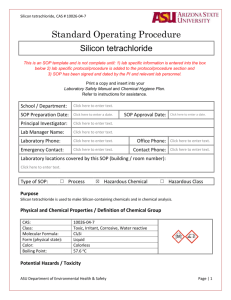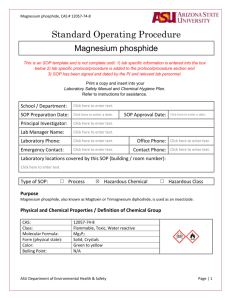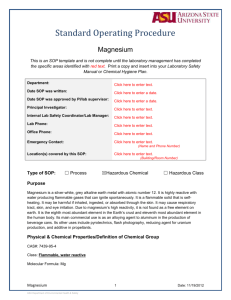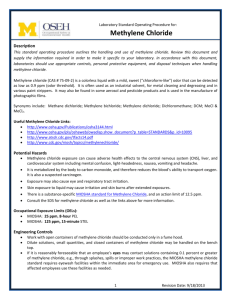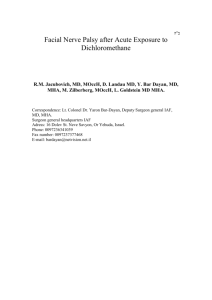Dichloromethane - Arizona State University
advertisement
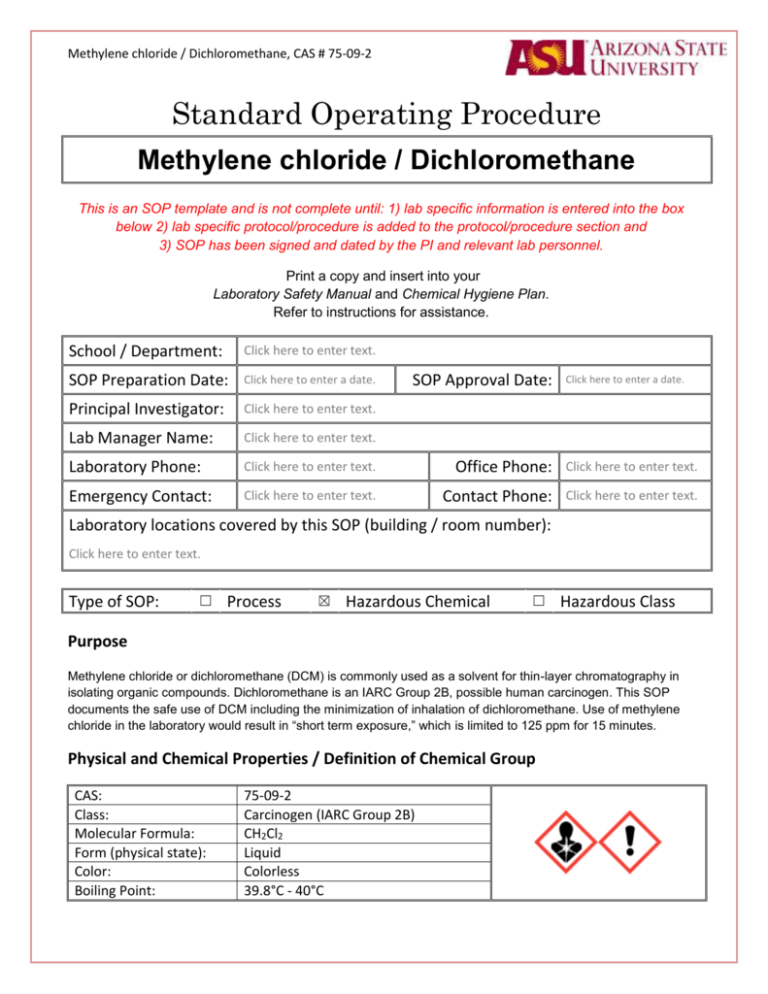
Methylene chloride / Dichloromethane, CAS # 75-09-2 Standard Operating Procedure Methylene chloride / Dichloromethane This is an SOP template and is not complete until: 1) lab specific information is entered into the box below 2) lab specific protocol/procedure is added to the protocol/procedure section and 3) SOP has been signed and dated by the PI and relevant lab personnel. Print a copy and insert into your Laboratory Safety Manual and Chemical Hygiene Plan. Refer to instructions for assistance. School / Department: Click here to enter text. SOP Preparation Date: Click here to enter a date. Principal Investigator: Click here to enter text. Lab Manager Name: Click here to enter text. Laboratory Phone: Click here to enter text. Office Phone: Click here to enter text. Emergency Contact: Click here to enter text. Contact Phone: Click here to enter text. SOP Approval Date: Click here to enter a date. Laboratory locations covered by this SOP (building / room number): Click here to enter text. Type of SOP: ☐ Process ☒ Hazardous Chemical ☐ Hazardous Class Purpose Methylene chloride or dichloromethane (DCM) is commonly used as a solvent for thin-layer chromatography in isolating organic compounds. Dichloromethane is an IARC Group 2B, possible human carcinogen. This SOP documents the safe use of DCM including the minimization of inhalation of dichloromethane. Use of methylene chloride in the laboratory would result in “short term exposure,” which is limited to 125 ppm for 15 minutes. Physical and Chemical Properties / Definition of Chemical Group CAS: Class: Molecular Formula: Form (physical state): Color: Boiling Point: 75-09-2 Carcinogen (IARC Group 2B) CH2Cl2 Liquid Colorless 39.8°C - 40°C Methylene chloride / Dichloromethane, CAS # 75-09-2 Potential Hazards / Toxicity Potential Health Effects carcinogen, target organ effect, harmful by ingestion, irritant Target Organs: Liver, pancreas, blood, central nervous system, heart, kidney Inhalation: May be harmful if inhaled. Causes respiratory tract irritation. Skin: Harmful if absorbed through skin. Causes skin irritation. Eyes: Causes eye irritation. Ingestion: Harmful if swallowed. Exposure Effects Very hazardous in case of eye contact, inhalation, or ingestion. In case of ingestion, DCM may cause irritation of the gastrointestinal tract and vomiting. If vomiting Acute: results in aspiration, chemical pneumonia could follow. Absorption through gastrointestinal tract may produce symptoms of central nervous system depression ranging from light headedness to unconsciousness. Can cause headache, mental confusion, depression, liver effects, kidney effects, Chronic: bronchitis, loss of appetite, nausea, lack of balance, and visual disturbances. Can cause dermatitis upon prolonged skin contact. Mutagenic: Methylene chloride may cause cancer in humans. Developmental: This substance is toxic to lungs, the nervous system, liver, mucous membrane. Exposure Limits / Toxicity LD50 / LC50: PEL: REL / TLV: IDLH: 1600 mg/kg [Rat] / 52,000 mg/m3 [Rat] 25 ppm ST 12.5 ppm (8-hour TWA – Action Level) n/a 2,300 ppm Personal Protective Equipment (PPE) The level of skin and eye protection should be selected based on the potential for splashing and other forms of exposure. Lab personnel intending to use/wear a respirator mask must be trained and fit-tested by EH&S. This is a regulatory requirement. (http://www.asu.edu/uagc/EHS/documents/asu_respriatory_protection_plan.pdf) Hand Protection When handling this chemical, wear laminate film or polyvinyl alcohol (PVA) gloves. Recommended combination of nitrile gloves with outer polyvinyl alcohol (PVA). Replace gloves when splash occurs. Methylene chloride / Dichloromethane, CAS # 75-09-2 NOTE: Consult with your preferred glove manufacturer to ensure that the gloves you plan on using are compatible with Methylene chloride. Refer to glove selection chart from the links below: http://www.ansellpro.com/download/Ansell_8thEditionChemicalResistanceGuide.pdf OR http://www.allsafetyproducts.biz/page/74172 OR http://www.showabestglove.com/site/default.aspx OR http://www.mapaglove.com/ Eye Protection Wear chemical splash goggles or a face shield to protect from splash hazards and chemical vapors. Skin & Body Protection Flame-resistant lab coat – avoid the use of traditional cotton-polyester white lab coat, which may readily collect or absorb compounds. Full-length pants Closed-toed impervious footwear Hygiene Measures Avoid contact with skin, eyes, and clothing. Wash hands before breaks and immediately after handling the product. Engineering Controls All operations involving Methylene chloride and dilutions should be carried out in a certified chemical fume hood or a ducted Biosafety cabinet to keep airborne level below recommended exposure limits. Chemical fume hoods designated as containment areas for particularly hazardous substances, like Methylene chloride, must have an average face velocity between 80 – 100 cfm. The fume hood must be certified annually – verify current certification and working condition prior to use. First Aid Procedures If inhaled… Remove rapidly to clean air. Administer rescue breathing if necessary and call emergency services. Seek medical attention if needed. Methylene chloride / Dichloromethane, CAS # 75-09-2 In case of skin contact… Minor skin contact requires washing with soap and water. Soaking or flushing contaminated areas of the skin with water for periods up to 15 minutes is required if a large area comes into contact with the chemical, or if prolonged contact occurs. Contaminated clothing may hold the chemicals in contact with the skin without being immediately noticed. In case of eye contact… The eye should be immediately flushed with water using the nearest emergency eyewash facility for 15 minutes. If the chemical is very irritating, it is likely that the affected individual will require assistance to hold the eye open during the flushing. Additional medical attention may be required. If swallowed… DO NOT INDUCE VOMITING. Give milk or water if conscious. Never give anything by mouth to an unconscious person. Consult a physician. Special Storage & Handling Requirements Storage Keep in tightly closed container. Store in a cool, dry, well-ventilated area. Protect against physical damage. Isolate from any source of heat or ignition. Store in a secondary containment, isolate from other chemical compounds with proper labeling. Label secondary containment / cabinet with “REGULATED CARCINOGEN”. DCM can be stored in the same cabinet as other regulated carcinogens. Segregate this chemical from incompatible materials as described in the ASU Chemical Hygiene Plan (CHP) and/or the Material Safety Data Sheet (MSDS). Handling (Designated Areas) Designated area(s) for use and storage of Methylene chloride must be established. Contact ASU Department of Environmental Health & Safety (EH&S) for assistance, (480) 965-1823. Work inside an active, annually certified fume hood posted as a “Designated Use Area for Methylene Chloride” and “Danger, Cancer Hazard”. Ensure you are wearing the following minimum PPE: safety goggles or face shield, lab coat & gloves, full length pants, closed-toed impervious shoes. Wash thoroughly after handling. Spill and Accident Procedure Spill Assess the extent of danger. Help contaminated or injured persons. Evacuate the spill area. Avoid breathing vapors. If possible, confine the spill to a small area using an available spill kit or absorbent material. Keep others from entering contaminated area (e.g use tape, barrier, etc.) Methylene chloride / Dichloromethane, CAS # 75-09-2 Small Spill ( < 1 Liter ) Use appropriate personal protective equipment and clean-up material for chemical spilled. Double-bag spill waste in clear plastic bags, attach Hazardous Waste tag and arrange pickup. Large Spill ( > 1 Liter ) Follow posted ASU Emergency Response Guide for Hazardous Materials Incidents. Dial 9-1-1 and contact ASU EH&S at (480) 965-1823 for assistance. Chemical spill on body or clothes Remove clothing and rinse body thoroughly in emergency shower for at least 15 minutes. Seek medical attention. Notify supervisor and ASU EH&S at (480) 965-1823. Chemical splash into eyes Immediately rinse eyeball and inner surface of eyelid with water from the emergency eyewash station for 15 minutes by forcibly holding the eye open. Seek medical attention. Notify supervisor and ASU EH&S at (480) 965-1823. Medical Emergency Life threatening emergency, after hours, weekends and holidays Dial 9-1-1. Note: all injuries and incidents must be reported to ASU EH&S, (480) 965-1823. Non-life threatening emergency Report to your ASU campus Health Services Center (451 E. University Drive, south side of University Drive, west of Palm Walk, Hours: M-F, 8am – 6pm, Sat., 10am – 2pm). Outside of these hours, report to Tempe St. Luke’s ER, 1500 S. Mill Avenue. Note: all injuries and incidents must be reported to ASU EH&S, (480) 965-1823. Needle-stick / puncture exposure Wash the affected area with antiseptic soap and warm water for 15 minutes. For mucous membrane exposure, flush the affected area for 15 minutes using an eyewash station. Report to your ASU campus Health Services Center (451 E. University Drive, south side of University Drive, west of Palm Walk, Hours: M-F, 8am – 6pm, Sat., 10am – 2pm). Outside of these hours, report to Tempe St. Luke’s ER, 1500 S. Mill Avenue. Note: all injuries and incidents must be reported to ASU EH&S, (480) 965-1823. Decontamination / Waste Disposal Procedure No waste streams containing Methylene chloride shall be disposed of in sinks. Decontaminate work space with 70-75% ethanol. Wash hands and arms with soap and water after finished. Contaminated pipette tips, tubes and gloves should be collected as hazardous waste. Methylene chloride / Dichloromethane, CAS # 75-09-2 Label waste Attach a completed ASU Hazardous Waste tag to all waste containers as soon as the first drop of waste is added to the container. Containers of Methylene chloride waste must be labeled with the following: “DANGER, CANCER HAZARD”. Store waste Store hazardous waste in closed containers, in secondary containment and in a designated storage location. Double-bag dry waste using sealable transparent bags. Waste must be under the control of the person generating and disposing of it. Dispose of waste Dispose of regularly generated chemical waste within 90 days. Use EHS Assistant online hazardous waste pick-up request system. Contact ASU EH&S at (480) 965-1823 with questions. Protocol / Procedure Laboratory-specific procedures Add your lab’s specific procedures in this section. IMPORTANT NOTE: Any deviation from this SOP requires advance PI approval. Documentation of Training Prior to conducting any work with Hydrofluoric acid (HF), Principal Investigator or designee must provide to his/her laboratory personnel specific to the hazards involved in working with this substance, work area decontamination, and emergency procedures. The Principal Investigator must provide his/her laboratory personnel with a copy of this SOP and a copy of the MSDS provided by the manufacturer. The Principal Investigator must ensure that his/her laboratory personnel have attended appropriate/required laboratory safety training or refresher training within the last one year. I have read and understand the content of this SOP. Employee Name ASU Affiliate No. Click here to enter text. Click here to enter text. Click here to enter text. Click here to enter text. Click here to enter text. Click here to enter text. Click here to enter text. Click here to enter text. Signature Date Click here to enter a date. Click here to enter a date. Click here to enter a date. Click here to enter a date.
